I’ve always been fascinated by how tribal braids styles blend centuries of tradition with contemporary fashion. Dating back as far as 500 BCE, these intricate hairstyles aren’t just stunning to look at – they’re deeply rooted in African heritage, once used to identify tribes, social status, and even age.
Over the years, I’ve watched tribal braids hairstyles surge in popularity, and for good reason. From the distinctive Fulani tribal braids styles with their unique cornrow patterns in front and box braids in back, to freestyle tribal braids featuring bold zigzag patterns and geometric shapes – each style tells a story. What I truly love about tribal braid styles is their versatility. You can adorn them with beads and shells for a traditional look or incorporate curly hair for a more bohemian vibe. Certainly, these hairstyles serve as both fashion statements and meaningful connections to cultural heritage. Whether you’re drawn to them for their beauty or their symbolism, here are 15 head-turning tribal braids that will dominate 2025.
Fulani Tribal Braids with Beads
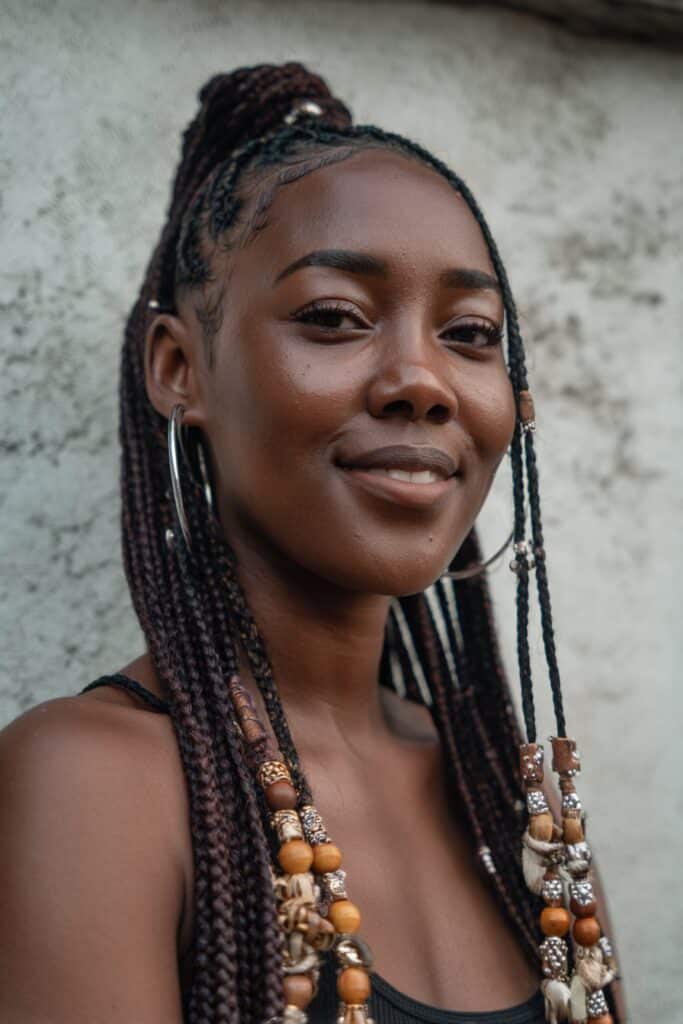
Whenever I think of traditional African hairstyles that have maintained their relevance, Fulani tribal braids with beads immediately come to mind. This iconic style stands as a perfect bridge between ancient tradition and modern fashion.
Style Description
Fulani braids originated from the Fulani (also called Fula) people – a nomadic ethnic group that has inhabited West Africa, the Sahel, and parts of the Sahara for centuries. What makes this tribal braids style instantly recognizable is its distinctive pattern. The classic design features a cornrow braided down the center of your head from front to back, with additional cornrows on each side braided from back to front. Many authentic versions also include a braid wrapped around the perimeter of the head, though modern interpretations often omit this element.
The most eye-catching aspect of these tribal braid styles is the decorative elements. Traditional Fulani tribal braids are adorned with beads, cowrie shells, and metal accents – each carrying cultural significance. These ornaments weren’t merely decorative; they symbolized beauty, wealth, cultural pride, and even indicated social status, marital status, and tribal origin.
Why It Turns Heads
I’ve noticed that Fulani tribal braids styles command attention for several compelling reasons. First, their intricate patterns create a visual symphony that frames the face beautifully. The contrast between the tight cornrows and the hanging braids creates dimension that flatters virtually every face shape.
Additionally, the decorative elements add a mystique that’s both elegant and eye-catching. The beads catch light as you move, creating a subtle shimmer effect that’s simply mesmerizing. There’s also something profoundly striking about wearing a hairstyle with such deep cultural roots – it carries an authenticity that contemporary styles often lack.
Furthermore, these braids offer tremendous versatility. You can wear them up or down, making them perfect for both casual and formal occasions. The style has been embraced by celebrities and fashion icons, helping cement its status as both culturally significant and fashion-forward.
How to Style It
I’ve found creating Fulani tribal braids requires patience and some technical skill. Here’s what you’ll need:
- At least four packs of braiding hair (more for thicker hair)
- Rat tail comb for precise partings
- Beader tool (optional but helpful)
- Decorative elements (beads, cowrie shells, metal cuffs)
- Gel (optional)
- Small rubber bands
Start by parting your hair and creating that signature center cornrow running from front to back. Then, add the side cornrows, which typically flow from back to front above the ears. For the remaining hair, create single braids in your preferred size.
The feed-in technique works beautifully for these braids – adding extensions little by little as you braid rather than all at once. This creates a more natural look with braids that appear thinner at the roots and thicker toward the ends.
For adding beads, I either use a beader tool or simply twist and fold the ends of the braids to make them thin enough to slide beads onto. Secure with small rubber bands and dip the ends in hot water to seal.
Side Part Tribal Braids

Looking for a subtle yet striking change to your protective style? Side part tribal braids have become my signature recommendation when clients want something distinctively modern without straying too far from tradition.
Style Description
Side part tribal braids create an asymmetrical, fashion-forward look by simply shifting the parting line from center to side. Unlike traditional middle-parted styles, this adjustment transforms the entire appearance by framing the face asymmetrically. What I love most about this variation is how it blends classic tribal braiding techniques with contemporary styling sensibilities.
The side part creates a flattering frame that accentuates your facial features while allowing for incredible versatility. Many of my clients opt to leave the ends out of the braids, showcasing their natural curly texture for a carefree, effortless vibe while keeping the protective benefits intact.
Why It Turns Heads
I’ve noticed side part tribal braids consistently draw attention for several compelling reasons. First, they accentuate cheekbone structure and naturally draw eyes to your jawline. This subtle asymmetry creates visual interest that standard center-parted styles simply can’t match.
Moreover, this style offers impressive versatility. You can dress it up for formal occasions or keep it casual for everyday wear. The side part creates a modern twist on the classic tribal braids that feels fresh and contemporary while honoring traditional techniques.
What truly makes this style special is its ability to enhance your natural features. The asymmetrical pattern makes a unique statement that’s both bold and refined – essentially a cultural celebration that marries tradition with contemporary flair.
How to Style It
When creating side part tribal braids, I follow these steps for best results:
- Start with freshly washed and conditioned hair
- Create your side part using a rattail comb – make it deep and dramatic for maximum impact
- Section your hair accordingly, using clips to keep organized
- Begin braiding sections following your desired pattern
- For added dimension, consider leaving the ends out to showcase your natural texture
For a truly head-turning look, experiment with mixing in other elements like box braids on one side for unique asymmetry and additional texture. This creates a stunning contrast that elevates the entire style.
Finally, maintain your side part tribal braids by wrapping them at night and applying light oil to your scalp. With proper care, this versatile style can last for several weeks while protecting your natural hair.
Half-Up, Half-Down Tribal Braids
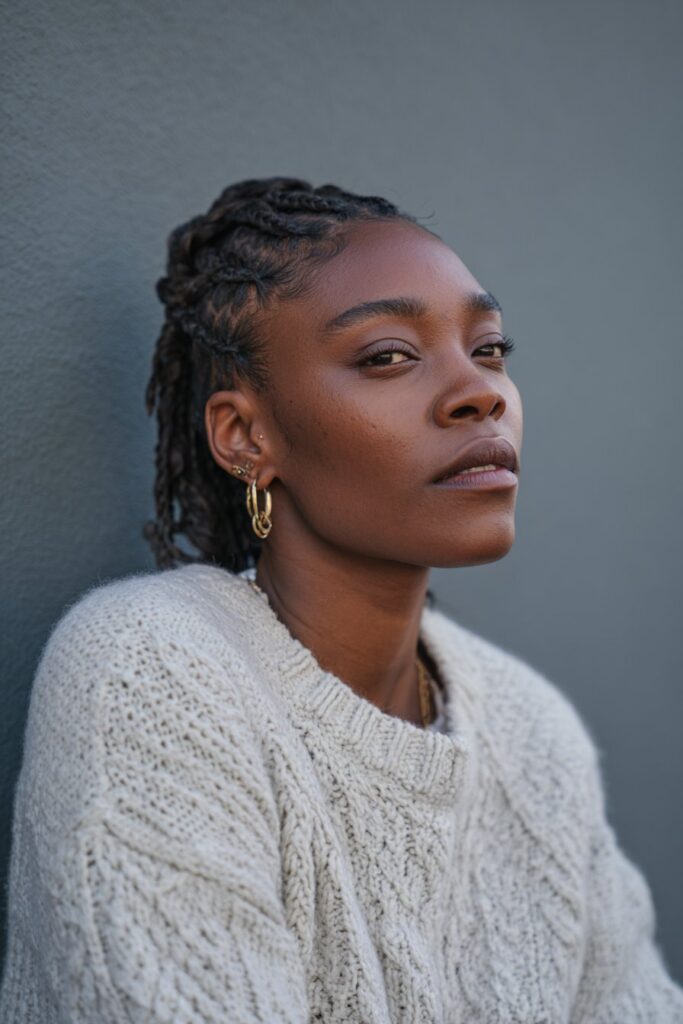
For my clients who want the best of both worlds, I always suggest the half-up, half-down tribal braids style—a perfect marriage of sophistication and casual elegance.
Style Description
Half-up, half-down tribal braids combine the accessibility of an updo with the beauty of freely flowing braids. This versatile style features the upper portion of your braids styled into some type of updo—typically a bun, ponytail, or series of twists—while the lower half cascades freely down your back. The contrast between the structured top and flowing bottom creates a balanced look that works for virtually any occasion.
In fact, what makes this style truly special is its adaptability. You can create a half-up bun with face-framing braids for a softer appearance, or opt for playful space buns on top for a more edgy, festival-ready look. Some of my clients prefer a simple half-up ponytail that keeps hair off the face while showcasing the beauty of their tribal braids.
Why It Turns Heads
The half-up, half-down tribal braids style commands attention because it offers dimension and visual interest that fully up or down styles sometimes lack. Besides its esthetic appeal, this style is remarkably comfortable—perfect for those who find full updos too tight yet want hair away from their face.
Indeed, its versatility is unmatched—appropriate for casual outings, professional settings, or formal events. I’ve created this style countless times for clients attending everything from business meetings to weddings, simply by adjusting the formality of the updo portion.
How to Style It
Creating this look requires minimal additional effort after your tribal braids are installed:
- Decide which portion of your hair will form the updo (usually the top third or half)
- Gather that section and style according to preference—a simple bun, ponytail, or space buns
- Secure with a hair tie that matches your braid color
- For extra flair, incorporate accessories like gold cuffs or beads in the updo portion
- Apply lightweight oil to your scalp and braids to maintain moisture and prevent frizz
To preserve this style overnight, I recommend loosely wrapping the updo portion in a silk scarf while leaving the down section free or loosely braided. With proper care, this striking look can last for weeks, honoring cultural roots while expressing your personal style.
Tribal Braids with Gold Cuffs

The elegance of metallic accents has revolutionized tribal braids styles in recent years. As a stylist, I’ve seen firsthand how gold cuffs transform traditional braided looks into statement pieces that celebrate both heritage and modern fashion sensibilities.
Style Description
Tribal braids with gold cuffs elevate classic braided styles by incorporating shiny metallic tubes that wrap around individual braids. These decorative elements, often called dread cuffs or filigree tubes, are thin metal pieces with an opening on one side that can be gently pulled wide and then bent back into place once positioned on the braid. In the light of cultural significance, gold cuffs represent a contemporary expression of the long-standing tradition of hair adornment in African cultures.
Historically, hair ornaments have been worn by women across the Sahel region for centuries, with silver or bronze disks passed down through generations. Subsequently, the modern gold cuff trend reflects this heritage while adding a luxurious, fashion-forward twist to tribal braids hairstyles.
Why It Turns Heads
Gold cuffs command attention through their eye-catching metallic shine. Their reflective quality creates dimension and movement as light plays across the braids. Undeniably, the contrast between the natural texture of the braids and the polished metal creates visual interest that elevates the entire look.
What makes this tribal braid style particularly appealing is its versatility. The cuffs can be:
- Strategically placed for subtle elegance
- Abundantly applied for bold glamor
- Combined with other accessories like beads or shells
Overall, gold cuffs have gained popularity particularly for special events and occasions where “glam needs a touch.” They offer a modern twist to traditional styles without sacrificing cultural connection, making them perfect for those who appreciate both heritage and contemporary fashion.
How to Style It
Adding gold cuffs to tribal braids is surprisingly straightforward. First, obtain quality cuffs from beauty supply stores, online marketplaces like Amazon, Etsy, or specialty shops like Loccessories. Soon after your braids are installed:
- Decide on placement—spacing them out looks more elegant than overcrowding
- Open the cuff gently along its side opening
- Position it around your chosen braid
- Press firmly but carefully to close the cuff around the braid
Pro tip: Place cuffs in varied locations—some near the front, others at the back or middle—for balanced visual interest. Together with proper spacing, this prevents the accessories from appearing overwhelming or haphazard.
For maintenance, be gentle when washing or sleeping to avoid bending or dislodging the cuffs. Such care will ensure your tribal fulani braids with gold accents continue to make a stunning impression throughout their wear time.
Freestyle Tribal Braids with Zigzag Patterns

As a stylist who loves pushing creative boundaries, I find freestyle tribal braids with zigzag patterns perfect for clients seeking something truly distinctive. These eye-catching styles blend traditional braiding techniques with modern, geometric flair.
Style Description
Freestyle tribal braids with zigzag patterns feature complex and detailed designs that incorporate sharp, angular patterns into the braided style. Unlike standard straight-parted braids, these styles use distinctive zigzag partings that create dynamic visual interest throughout the hair. Zigzag tribal braids can be styled in various ways—from zigzag partings with straight braids to fully zigzag-patterned braids that follow the angular sectioning.
Historically, these patterns draw inspiration from traditional African tribal designs. The freestyle element allows for artistic expression beyond rigid patterns, incorporating twists, turns, swirls, and cross-over braids for a truly unique look. Typically, this style includes bohemian-style hair with dramatic edges to complete the esthetic.
Why It Turns Heads
Zigzag tribal braids command attention through their:
- Bold, unconventional appearance perfect for those wanting a unique, attention-grabbing hairstyle
- Artistic craftsmanship that demonstrates high-level skill in braid artistry
- Dynamic visual movement that creates the illusion of ripples across the scalp
- Versatility in being paired with various colors, including striking blonde options for contrast
Naturally, the sharp angles and precise geometric patterns create an edgy yet sophisticated look that’s impossible to ignore. The experimental nature of these braids makes them ideal for anyone with adventurous taste looking to make a statement.
How to Style It
Creating freestyle zigzag tribal braids requires patience and attention to detail:
Initially, section clean hair and determine your zigzag pattern. For beginners, I recommend making the first line from hairline to first curve relatively straight before adding zigzags—this ensures you don’t run out of space before completing the pattern.
To create sharp, defined points in your zigzag pattern, make straight lines at each bend point and connect them to previous sections. This technique creates cleaner, more defined angles than attempting curved motions.
Alternatively, you can incorporate zigzag partings with straight braids or follow the zigzag pattern with your actual braiding technique. Both approaches create striking results but offer different final looks.
Accessorize with beads, shells, or colorful threads to enhance the artistic effect of your freestyle tribal style.
Tribal Braids with Curly Ends

The beautiful contrast between structure and softness is what draws me to tribal braids with curly ends. This style has become one of my favorite recommendations for clients seeking a look that’s both structured and playful.
Style Description
Tribal braids with curly ends combine the precision of tight, traditional braiding with soft, bouncy curls that cascade from the ends. This fusion creates a striking visual contrast – structured geometric patterns near the scalp transitioning into free-flowing, voluminous curls. Historically, these styles connect wearers to centuries of African heritage while embracing modern esthetics.
The style typically features tightly braided sections that flow about two-thirds down the length before transitioning into loose, natural-looking curls. In traditional Fulani versions, distinctive cornrow patterns are braided down the middle of the head, with smaller cornrows along the sides, all culminating in those eye-catching curly ends.
Why It Turns Heads
Naturally, the juxtaposition of neat, linear braids against soft, bouncy curls creates visual interest that plain braids simply can’t match. The curly elements add a special touch by softening the geometric precision of tribal patterns, creating a more romantic, bohemian vibe.
This style is particularly striking because it offers the best of both worlds – the cultural significance and protective benefits of tribal braids plus the feminine softness of curls. Additionally, the dimension and movement provided by the curly ends make this style dynamic and perfect for those wanting something uniquely eye-catching.
How to Style It
First thing to remember when creating tribal braids with curly ends is to decide how much curl you want. For subtle results, I recommend adding 4-6 strands of curly hair per braid. For more dramatic volume, use 6-8 strands.
To achieve this look:
- Begin by creating your tribal braid pattern of choice (Fulani or other styles work well)
- Braid about two-thirds down each section
- Add in curly hair extensions as you braid
- Secure the transition point between braid and curl with a small rubber band
- For maintenance, wrap hair at night and apply light moisturizer to keep curls bouncy
In contrast to fully braided styles, these curly-ended creations require minimal additional styling – the curls naturally create movement and dimension that elevate the entire look.
Tribal Braids with Shell Accents
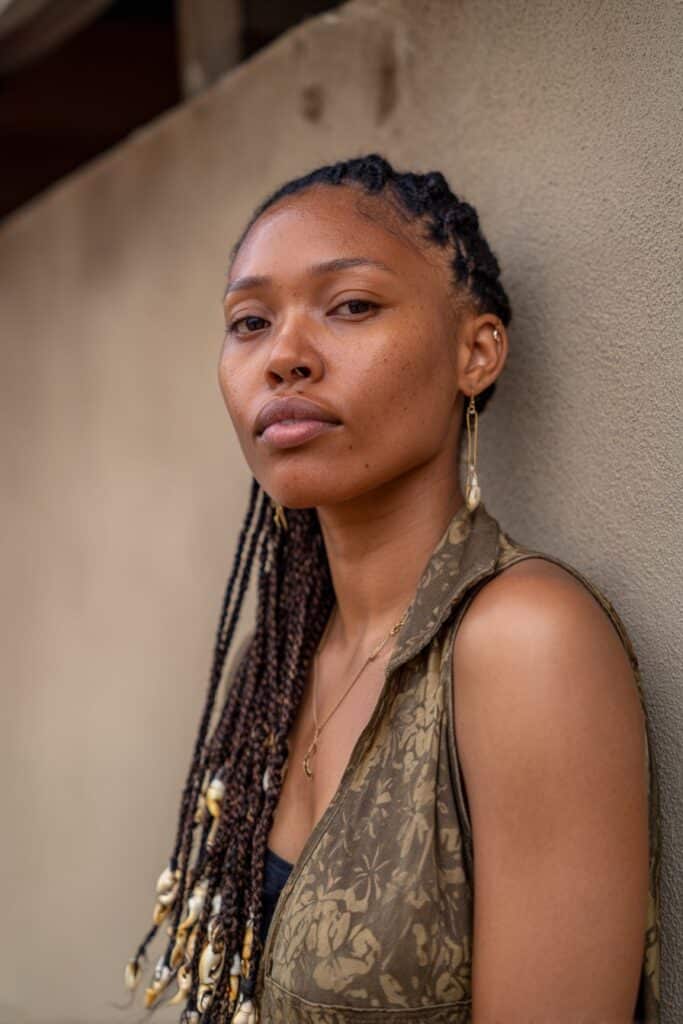
Shell accents bring a touch of oceanic beauty to tribal braids, creating a style that’s both culturally rich and visually captivating. Throughout my years as a stylist, I’ve noticed clients gravitating toward this distinctive look that honors African heritage while making a contemporary fashion statement.
Style Description
Tribal braids with shell accents feature decorative shells—typically cowrie shells—woven into or attached to braided hair. Historically, these shells adorned the braids of Fulani women and played essential roles in various ceremonies including weddings and coming-of-age rituals. Cowrie shells specifically weren’t merely decorative; they symbolized wealth, fertility, and earthiness across many African cultures.
The style can vary significantly—from chunky tribal braids with shells threaded sporadically throughout to diagonal braids with cowrie shells lining the edges. Alternatively, layered tribal braids with shell accents create multiple levels of braids, each adorned with small shells that add oceanic flair.
Why It Turns Heads
Naturally, shell-adorned tribal braids command attention through their distinctive appearance. The stark contrast between the organic, natural shells and the structured braids creates visual interest that plain styles simply can’t match. Consequently, this style makes a powerful statement that’s simultaneously elegant and culturally significant.
What makes this style particularly appealing is its versatility. You can customize:
- Shell placement (sporadic or patterned)
- Shell types (cowrie shells being most traditional)
- Shell quantity (subtle accent or statement-making abundance)
How to Style It
When creating tribal braids with shell accents for my clients, I start by selecting appropriately sized shells—smaller shells work best with skinnier braids, whereas larger shells complement chunky styles. To attach shells:
- Fold the end of your braid slightly to make it thinner
- Thread it through the shell’s opening
- Pull it through until the shell sits at your desired position
- Secure with a small knot if needed
For maintenance, apply light oil to your scalp and braids while being gentle around shell attachments when washing or sleeping.
Jumbo Tribal Braids with Low Bun
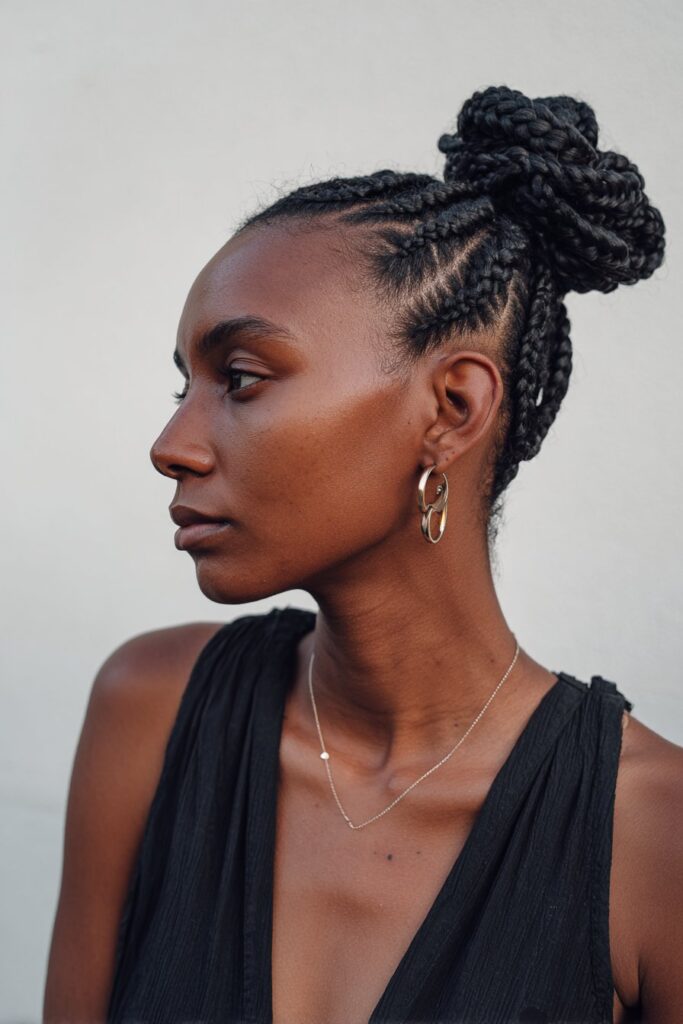
Jumbo tribal braids with a low bun offer the perfect combination of boldness and practicality that my clients constantly request. This head-turning style delivers maximum impact with minimal styling time.
Style Description
Jumbo tribal braids are characterized by their larger, thicker sections that create a dramatic statement look. Unlike standard tribal braids styles, these chunky versions showcase intricate patterns and textures on a grander scale. When these bold braids are gathered into a sleek low bun positioned at the nape of the neck, the result is both sophisticated and striking.
What makes this style particularly distinctive is its versatility. The jumbo braids provide the visual impact, naturally drawing attention to their size and pattern, while the low bun creates a polished, refined silhouette. Chic yet understated, this combination works wonderfully for both casual outings and more formal occasions.
Why It Turns Heads
Jumbo tribal braids with a low bun command attention for several compelling reasons. Primarily, the oversized nature of the braids creates an immediate visual impact that’s impossible to ignore. The substantial thickness of each braid demonstrates a bold confidence that makes a strong statement without saying a word.
Practically speaking, this style offers significant advantages:
- Reduced installation time compared to smaller braids
- Low-maintenance daily styling
- Impressive longevity (up to two weeks with proper care)
The sleek low bun element adds sophistication to the boldness of jumbo tribal braids, creating a balanced look that transitions seamlessly between casual and formal settings. This style truly excels in its ability to protect natural hair while simultaneously making a fashion statement.
How to Style It
Creating jumbo tribal braids with a low bun requires fewer materials than you might expect. Start with clean hair and gather:
- Marley braiding hair or other kinky textured extensions
- Hair ties that match your braid color
- Bobby pins
- Lightweight hair oil
- Optional accessories (beads, cuffs)
Generally, I recommend sectioning your hair according to your desired pattern, considering your face shape when choosing partings. After installing your jumbo tribal braids, simply gather them into a low ponytail at the nape of your neck, using a headband as your hair tie for a thicker base.
From there, you can either wrap the braids around the ponytail base or split them into two sections, wrapping each in opposite directions to create a more intricate bun. Secure with bobby pins and tuck in any stray ends for a polished finish.
For nighttime protection, loosely wrap the bun in a silk scarf to prevent friction while sleeping.
Tribal Braids with Forehead Braid
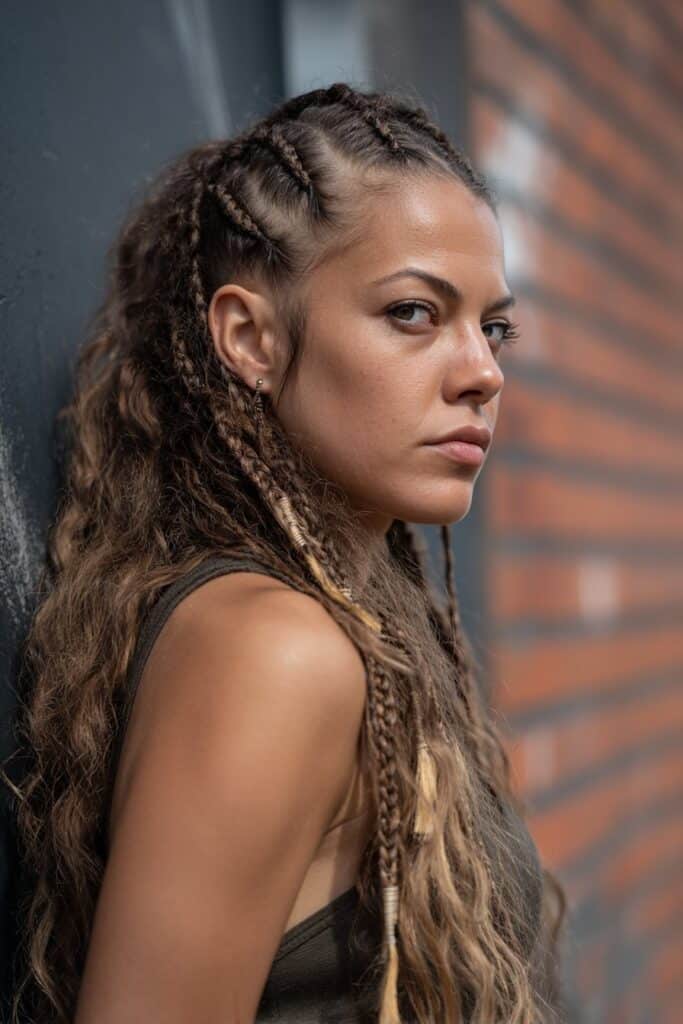
During my years as a hairstylist, forehead braids have emerged as one of the most distinctive elements that can transform standard tribal braids into something truly remarkable.
Style Description
Tribal braids with forehead braids feature a smaller, delicate braid that starts at the hairline and runs horizontally across the forehead, creating a striking frame for your face. Typically, this style includes traditional tribal braids throughout the rest of the hair, nonetheless allowing the forehead braid to stand out as the focal point. This arrangement isn’t merely decorative; it draws inspiration from traditional Fulani styles characterized by unique cornrow patterns in the front. Yet unlike standard tribal styles, the forehead braid adds an unmistakable bohemian element that seamlessly blends with the remaining tribal braids, creating a harmonious balance between tradition and contemporary fashion.
Why It Turns Heads
The forehead braid commands attention primarily through its distinctive positioning. By framing the face in such a bold, artistic manner, it creates a natural spotlight around your features. Notably, this style makes a strong statement without overwhelming your natural beauty—instead, it enhances it. The contrast between the delicate forehead braid and the fuller tribal braids creates visual interest that plain styles simply can’t match. Markedly different from other tribal braids hairstyles, this look carries an air of sophistication while maintaining cultural connections, making it perfect for those who appreciate both heritage and fashion-forward styling.
How to Style It
Creating tribal braids with a forehead braid requires precision and attention to detail:
- Begin by parting clean hair according to your desired tribal braid pattern
- Reserve a small section along the hairline for your forehead braid
- Braid the main sections first using your preferred tribal braiding technique
- For the forehead section, create a small, neat braid that runs horizontally across the forehead
- Ensure the forehead braid blends seamlessly with the rest of your style
Afterward, apply light oil to your scalp and braids for moisture and shine. With proper maintenance, this eye-catching style can last 4-6 weeks while continuing to make a powerful impression.
Ombre Blue Tribal Braids
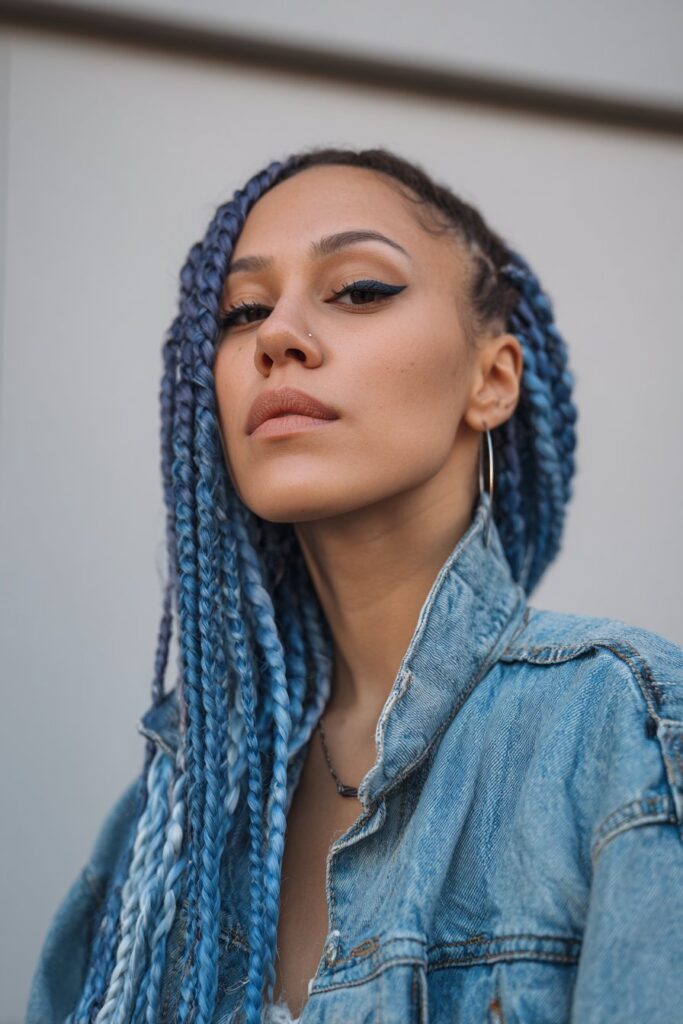
The gradient magic of ombre blue tribal braids offers a fresh twist on traditional styles that I’m constantly asked to create in my salon. This eye-catching variation combines cultural heritage with contemporary color techniques for truly show-stopping results.
Style Description
Ombre blue tribal braids feature a smooth transition of colors, starting with a darker blue shade at the roots and gradually fading into a lighter blue hue towards the ends. This captivating gradient effect adds remarkable depth and dimension to the braids, creating a visually dynamic appearance that standard single-color styles simply can’t match.
You can incorporate this ombre technique into various tribal braiding patterns. I’ve found the Fulani braid pattern works particularly well with blue ombre, as the distinctive cornrow design showcases the color transition beautifully. The vibrant blue hue adds a unique and edgy twist to traditional tribal braids, allowing for personal expression while maintaining cultural connections.
Why It Turns Heads
Whenever I create blue ombre tribal braids, they inevitably draw attention for their striking visual impact. The gradient effect creates a sense of movement and dimension that’s immediately noticeable. As an experienced stylist, I’ve observed that this style is especially eye-catching for those who appreciate bold hair colors yet want something more sophisticated than a single flat shade.
The style makes a powerful statement about individuality while still honoring traditional braiding techniques. Ultimately, the blue color symbolizes confidence and creative expression, making it perfect for clients who want to stand out from the crowd.
How to Style It
To achieve this look, I typically start by selecting high-quality ombre braiding hair in complementary shades of blue. For authentic results, you’ll need:
- Extension hair in at least two coordinating blue shades (dark blue for roots, lighter blue for ends)
- Standard braiding supplies (comb, clips, edge control)
Begin by braiding with the darker blue shade, gradually incorporating the lighter blue as you work down each braid. Alternatively, you can use pre-made ombre braiding hair, although I prefer the custom approach for a truly seamless transition.
Tribal Braids with Criss-Cross Design

The intricate geometry of criss-cross tribal braids never fails to fascinate my clients seeking a sophisticated yet bold protective style. This pattern-focused design elevates traditional tribal braiding into true artistry.
Style Description
Criss-cross tribal braids feature intricately braided sections arranged in a triangular pattern with braids that intersect each other, creating a woven effect. Unlike standard tribal styles, this design showcases deliberate overlapping that forms striking geometric shapes across the scalp. Typically, these braids are characterized by their tribal-inspired look, often enhanced with beads or decorative elements that accentuate the crossover points.
The unique triangular shape of the partings creates a visual framework that naturally draws attention to the face. Hence, the criss-crossing element adds complexity and texture to the style, making it stand out from simpler braided options. Despite its complexity, the style maintains cultural connections through its traditional tribal braiding techniques while incorporating modern geometric precision.
Why It Turns Heads
Criss-cross tribal braids command attention primarily through their artistic complexity. The intersecting patterns create dimension and visual interest that basic braided styles simply cannot achieve. Regarding esthetic appeal, the structured geometry of this style frames facial features beautifully, highlighting cheekbones and jawlines in a flattering way.
As a stylist, I’ve noticed clients choose this style for its:
- Creative, eye-catching appearance perfect for making a bold statement
- Unique pattern that showcases the wearer’s appreciation for detailed artistry
- Versatility in being paired with various braid sizes and lengths
The style’s striking yet sophisticated appearance works wonderfully for both casual settings and special occasions, making it remarkably versatile despite its distinctive appearance.
How to Style It
Creating criss-cross tribal braids requires patience and precision. Prior to beginning, section clean hair and decide on your triangular pattern layout. Namely, for beginners, I recommend planning the entire design before starting to ensure symmetry and proper spacing.
To achieve this look, start by dividing the part needed for the cross-cross pattern by splitting it into two sections. Next, split both sections into two (creating four sections total). Begin braiding section two and connect with section three, remembering to feed in less hair at connection points to maintain clean lines. Coupled with practice, your cornrow technique will improve with each attempt.
For finishing touches, consider adding beads or cuffs at intersection points to highlight the geometric pattern. This tribal braid style typically lasts 4-6 weeks with proper maintenance, making it both beautiful and practical.
Tribal Braids with Space Buns

Space buns combined with tribal braids have rapidly become my favorite playful yet sophisticated style recommendation. This youthful, vibrant look perfectly balances traditional braiding techniques with contemporary styling for clients seeking something uniquely eye-catching.
Style Description
Space buns with tribal braids feature two rounded buns positioned on either side of the head, typically at the crown or slightly higher. Interestingly, they’re sometimes called “double braided buns” and create a distinctive silhouette that’s immediately recognizable. After creating tribal braids throughout the head, the braids are gathered into two symmetrical sections and twisted into circular buns that resemble miniature planets—hence the cosmic name.
Primarily a wind-friendly style that works beautifully with every hair type, space buns offer remarkable versatility. They can be positioned higher for a more playful look or lower for subtlety. The tribal braiding element adds texture and cultural significance to what might otherwise be a purely modern style.
Why It Turns Heads
Space buns with tribal braids command attention for their bold, symmetrical appearance and youthful energy. Not only do they frame the face beautifully, but they also create a striking silhouette visible from all angles.
In this case, clients frequently tell me this style makes them “feel like a teenager again” while still honoring traditional braiding techniques. The combination creates a perfect balance—culturally significant yet contemporary, structured yet playful. For many of my clients, these buns represent the ideal fusion of heritage and modern fashion sensibilities.
How to Style It
Creating tribal braids with space buns requires:
- Curl gel
- Leave-in conditioner
- Nylon hair ties
- Detangling shower brush
To achieve this look:
- Start with tribal braids already installed in your preferred pattern
- Part your hair down the middle, creating two equal sections
- Secure each section with a hair tie, forming high ponytails
- Twist each ponytail around its base, forming a circular bun
- Secure with bobby pins, tucking ends underneath
- Pro tip: For fuller buns, gently pull the outer edges of each bun to create more volume
Even so, this style can be enhanced with accessories like gold cuffs or beads for additional flair. Completing the look with hoop earrings creates a harmonious esthetic that emphasizes the circular theme.
Tribal Braids with Colorful Yarn

I’ve fallen in love with colorful yarn tribal braids for clients seeking bold self-expression while protecting their natural hair. This vibrant style brings playfulness to traditional braiding techniques through unexpected pops of color.
Style Description
Colorful yarn tribal braids integrate bright, vibrant yarn woven into traditional braided patterns, adding striking pops of color and unique texture. Unlike conventional extensions, these braids use 100% acrylic yarn (this specific material is crucial) to create a protective style with extraordinary visual impact. Most people typically use yarn matching their natural hair color, yet the true beauty of this style emerges when embracing purples, blues, greens, pinks, and reds that transform ordinary braids into artistic statements.
This style speaks volumes about personal creativity while honoring cultural braiding traditions. Furthermore, yarn braids work exceptionally well for shorter hair—the shorter your natural hair, the less time you’ll spend braiding. For each braid, stylists generally use 60 strands of yarn to achieve the desired thickness, creating a full, dimensional look.
Why It Turns Heads
Colorful yarn tribal braids command attention through their unexpected vibrancy. Therefore, they make perfect conversation starters while showcasing the wearer’s artistic sensibility. The customizable nature of yarn colors means you can create a uniquely personal look—whether choosing a single bold shade or blending multiple hues for rainbow effects.
Beyond their visual appeal, these braids offer remarkable versatility as a low-maintenance protective style. In effect, yarn braids can typically last one to two weeks before needing replacement, making them ideal for those wanting temporary transformation without commitment. The thickness and texture of yarn also create fuller-looking braids compared to traditional extensions.
How to Style It
To create colorful yarn tribal braids:
- First, select 100% acrylic yarn only—other types will knot and damage hair.
- Measure by holding yarn from your head to desired length, adding extra half-inch for knotting.
- Section clean hair (thorough scalp washing is essential).
- Slide sectioned hair through looped yarn ends, keeping three strands in each hand.
- Give yarn one twist to secure before braiding.
- Finish with a slipknot—pull two sections together and use the third to create a secure knot.
- Optional: Carefully burn ends with a lighter in one-second increments for sealed tips.
For maintenance, consider applying light oil to your scalp and braids to maintain moisture and prevent flaking.
Tribal Braids with Micro Cornrows
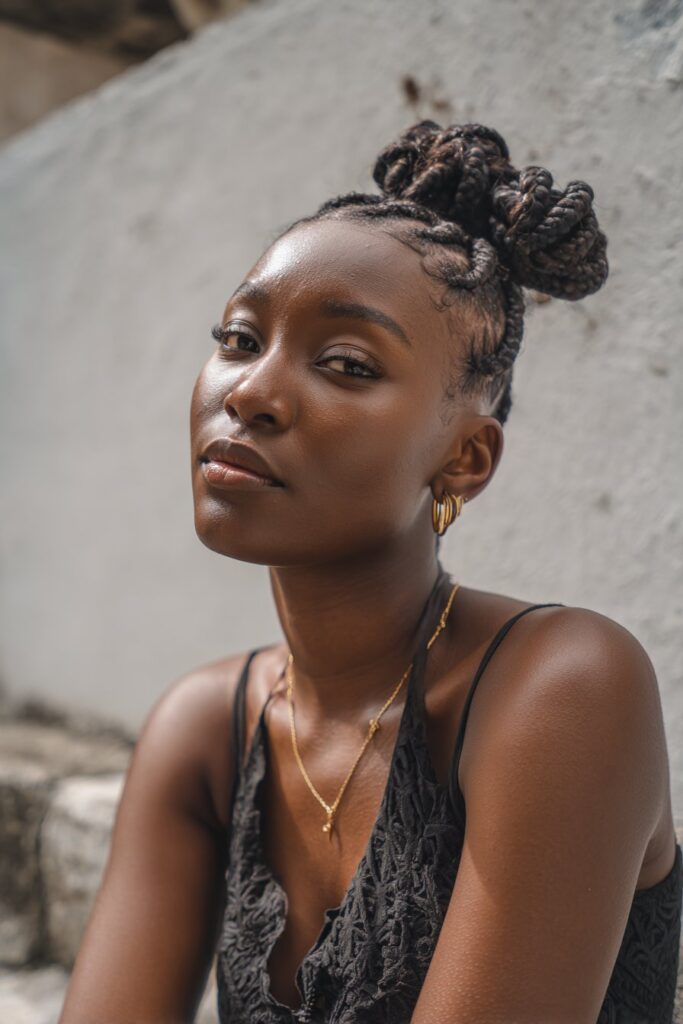
Micro cornrows paired with tribal braids create one of the most detailed and intricate protective styles I’ve ever crafted for my clients. This meticulous combination showcases extraordinary craftsmanship while honoring cultural braiding traditions.
Style Description
Micro cornrows integrated with tribal braids feature extremely thin, tightly woven cornrows that follow the natural curve of the scalp. Typically, these tiny braids are created using two or three micro locks per section, ensuring they’re not too thin when adding decorative elements like beads. This style draws inspiration from ancient African civilizations where cornrows originated, serving as more than just a hairstyle—they were cultural identifiers reflecting tribe, age, marital status, and social standing. Currently, the style combines traditional tribal patterns with incredibly detailed micro braiding techniques to create an elegant, textured look that adds remarkable depth and dimension to the overall appearance.
Why It Turns Heads
Micro cornrows within tribal braids capture attention primarily through their extraordinary intricacy and detailed artistry. Since these braids require exceptional skill and patience to create, they inherently showcase the wearer’s appreciation for craftsmanship. Furthermore, the unique texture and tight geometric patterns create visual interest that larger braids simply cannot achieve. These detailed designs frame facial features beautifully, highlighting natural bone structure while providing an elegant, sophisticated appearance perfect for those wanting a unique yet polished look.
How to Style It
Creating tribal braids with micro cornrows requires precision:
- Begin by sectioning clean, moisturized hair with water and aloe vera gel to ensure proper hydration
- Pre-part hair into sections, ensuring each micro cornrow section contains 2-3 strands for proper thickness and durability
- Apply a light mousse to smooth edges and create cleaner-looking braids
- For front sections, braid until reaching another micro lock, then incorporate it naturally
- Never braid too tightly, especially with micro locks, to prevent tension and damage
To maintain this style, apply lightweight oil to your scalp regularly and wrap with a silk scarf nightly for protection.
Tribal Braids with Crown Design
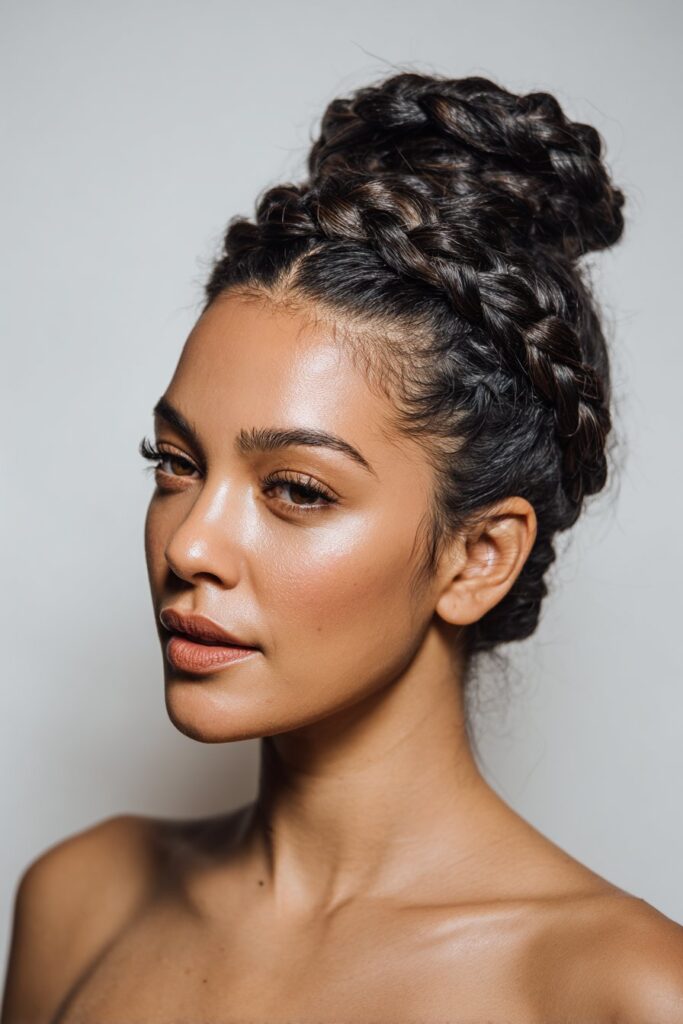
Crowning glory takes on new meaning with tribal braids arranged in a circular pattern. As someone who creates protective styles daily, I find crown design tribal braids offer that perfect blend of regality and cultural significance that many clients seek.
Style Description
Crown tribal braids feature an elegant circular pattern that wraps around the head like a halo or crown. Usually, these braids are arranged by taking sections from each side and wrapping them around the crown of the head, creating a sophisticated, regal appearance. The braids typically follow the natural curve of the scalp, forming a continuous circular design that frames the face beautifully. Historically, these designs draw inspiration from traditional West African braiding techniques, where hairstyles often represented cultural identity and social status.
Why It Turns Heads
Crown tribal braids command attention primarily because of their regal, majestic quality. The circular arrangement creates a balanced silhouette visible from all angles, making it impossible to ignore. Equally important, this style frames the face in a flattering way that highlights cheekbones and draws attention upward. Many of my clients choose this style for special occasions because it creates a sophisticated look perfect for weddings, festivals, or ceremonial events. The versatility is remarkable too—you can keep it minimal or elevate it with beads, shells, or silk flowers for added drama.
How to Style It
Creating tribal braids with a crown design requires patience and precision:
- Start with clean, moisturized hair sectioned according to your desired pattern
- Begin braiding at one side, following the curve of your head
- For traditional crown braids, Dutch braid (crossing strands underneath) works best
- Continue around your head, maintaining consistent tension
- Secure ends with small elastics, then tuck them underneath
For those with existing tribal braids, you can transform them into a crown style by wrapping sections around your head and securing with bobby pins. Occasionally, I remind clients that arms may tire during styling—taking breaks is perfectly acceptable when creating this intricate look.
Conclusion
Throughout my years of styling and celebrating tribal braids, I’ve witnessed firsthand how these 15 stunning styles seamlessly blend centuries-old traditions with contemporary fashion sensibilities. Undoubtedly, tribal braids represent more than just protective styling—they embody cultural heritage, personal expression, and artistic craftsmanship all beautifully woven together.
After exploring these head-turning styles, you might feel drawn to the regal elegance of crown designs or perhaps the playful energy of space buns combined with traditional patterns. Meanwhile, decorative elements like shells, beads, and gold cuffs add personal flair while honoring ancestral traditions that give these styles their profound significance.
What makes tribal braids truly special, though, is their remarkable versatility. Whether you prefer the distinctive Fulani pattern with its unique cornrow arrangement or the bold statement of jumbo braids gathered into a sleek low bun, these styles adapt wonderfully to different occasions, personalities, and preferences. Additionally, vibrant color options—from subtle ombre blues to rainbow yarn—allow endless customization possibilities that reflect your individual style.
My clients often tell me they feel a deeper connection to their heritage when wearing these styles, yet simultaneously appreciate how tribal braids complement modern fashion. This beautiful duality explains why these styles continually evolve while maintaining their cultural roots.
Remember, finding the right tribal braids style depends largely on your lifestyle, face shape, and personal esthetic. Patience during installation certainly pays off with weeks of low-maintenance beauty. The expert techniques featured throughout this article might seem complex, but qualified stylists can help bring these stunning looks to life.
Tribal braids will surely continue dominating protective styling trends beyond 2025, their timeless appeal transcending fleeting fashion moments. Most importantly, these styles celebrate both heritage and innovation—a powerful combination that keeps them eternally relevant.
Which tribal braids style speaks to you? The beauty awaits your personal interpretation.
